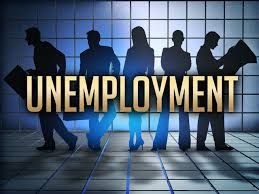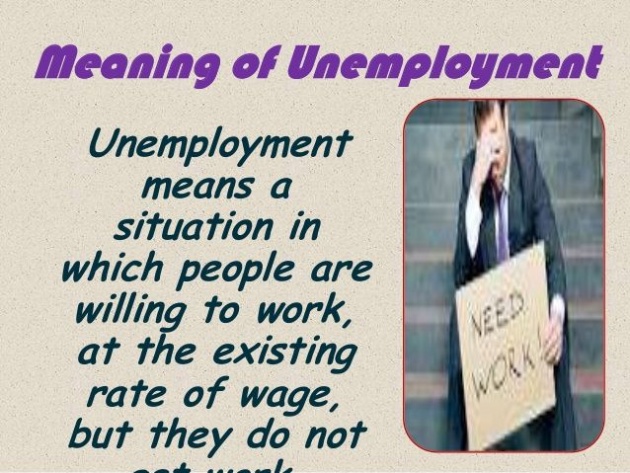UNEMPLOYMENT


Unemployment occurs when a person who is actively searching for employment is unable to find work. Unemployment is often used as a measure of the health of the economy. The most frequently cited measure of unemployment is the unemployment rate. This is the number of unemployed persons divided by the number of people in the labor force.
BREAKING DOWN 'Unemployment Rate'
As defined by the International Labor Organization (ILO), an unemployed person is someone who is actively looking for work but does not have a job. The unemployment rate is a measure of the number of people who are both jobless and looking for a job. This measurement is considered a lagging indicator, confirming but not foreshadowing long-term market trends.
To be considered actively looking for a job a person must be in contact with employers, getting interviews, reaching out to government employment agencies, or simply sending out applications four weeks prior to polling or who are in college. Economists prefer this measure because it controls for increases or decreases in population. However, for the lay-person the unemployment rate should be considered as one measure among several to consult among many when trying to understand the number of jobless.
Unemployment is measured in a number of ways in the U.S.: labor force sample surveys, Social Insurance statistics, which are numbers drawn from the number of people drawing unemployment benefits and other welfare programs, and employment office statistics which measure the number of people who come into unemployment offices looking for work. When calculating the official unemployment rate, the Bureau of Labor Statistics consider all the information gathered by these methods to provide a holistic picture of the labor market and the challenges facing workers.
In particularly tough economic times, the unemployment rate may be lower than the number of people out of work because the official rate only includes those actively looking for work. Those workers who have become discouraged and dropped out of the labor force are not counted in unemployment statistics. For the same reason, men or women who do not work for an employer, but work fulltime at home raising children are not factored into the official unemployment number.
Finding the Unemployment Rate
In the United States, the Bureau of Labor Statistics conducts a monthly survey of roughly 50,000 households called the Current Population Survey (CPS), and uses the results they get from that survey to produce the number for the unemployment rate. Expressed as a percentage, the rate of unemployment is found by dividing the number of unemployed workers by the total labor force, and multiplying it by 100%.
From 1948 to 2004, the monthly U.S. unemployment rate has ranged between about 2.5% to 10.8%, averaging approximately 5.6%. That average is not a sign of consistent economic woes for the U.S. because some degree of unemployment, even in highly developed countries is to be expected. Unemployment also comes in different varieties, such as frictional and structural and seasonal. Agricultural jobs are often seasonal, so the seasonal unemployment rate often increases during winter months.
Frictional unemployment refers to the time and energy it takes to get a job that contributes to a person being unemployed for a moderate period of time, while structural unemployment refers to a mismatch in the supply and demand of labor, for example when there simply isn’t much of a demand for labor or when there is a dearth of skilled labor to be hired.
Economists and policy makers get concerned when the unemployment rises above that of the natural unemployment rate, an estimate of what normal unemployment would be in comparison to a countries GDP when measured in the long run.
BREAKING DOWN 'Workers' Compensation'
Workers' compensation is a type of insurance that offers employees compensation for injuries or disabilities sustained as a result of their employment. By agreeing to receive workers' compensation, workers are also agreeing to give up their right to sue their employer for negligence. This "compensation bargain" is intended to protect both workers and employers. Workers give up further recourse in exchange for guaranteed compensation, while employers consent to a certain amount of liability while avoiding the potentially greater damage of a large-scale negligence lawsuit. All parties (including taxpayers) benefit from avoiding the legal fees needed to process a trial.
Workers' Comp Coverage
Most compensation plans offer coverage of medical fees related to injuries acquired as a direct result of employment. For example, a construction worker could claim compensation if scaffolding fell on their head, but not if they were in a traffic accident while driving to the job site. In other situations, workers can receive the equivalent of sick pay while they are on medical leave. If a worker dies as a result of their employment, workers' compensation also gives payments to their family members or other dependents.
While the "compensation bargain" excludes the possibility of a tort of negligence being issued by employees, this is not to say that compensation is a foregone conclusion. For one thing, it is not always clear whether or not an employer is actually liable for an injury to their worker. Furthermore, working injuries are chronically underreported in some industries.
Legally, there is no penalty for reporting a workplace injury to an employer, but this stipulation is impossible to regulate on an individual level, especially in industries like construction where a worker's livelihood depends to a degree on their physical abilities. Workers' compensation payments are also susceptible to insurance fraud: in some cases, workers will sustain an unrelated injury but report that it was sustained on the job.
Workers' compensation should not be confused with disability insurance or unemployment income; it only pays workers who are injured on the job, while disability insurance pays out regardless of when or where the insured is injured or disabled. Workers' compensation also does not cover unemployment. Unlike unemployment income or disability benefits, workers' compensation is always tax-free.
Workers' Comp at the State and Federal Level
In the United States, workers' compensation policy is usually handled by individual states. The Department of Labor houses an Office of Worker's Compensation Programs, but it is only responsible for compensation policies for federal employees, longshoremen and coal miners. The lack of federal standards for workers' compensation has resulted in deeply variant policies for the same kinds of injuries in different parts of the country. Therefore, it is essential for a worker acknowledging and preparing for the possibility of a work-related injury to carefully examine both state and company compensation literature.
Recent studies have shown that workers' compensation benefits have dropped substantially in a majority of states. Identical injuries can receive radically different kinds of compensation depending on where a worker resides, which makes it all the more important to examine local compensation statutes. Meanwhile, studies have shown that incommensurate workers' compensation is closely correlated with persistent income inequality.



